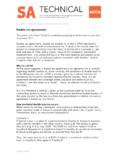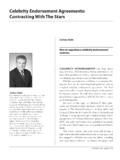Transcription of Share purchase agreements - EY - United States
1 Share purchase agreements ernst & young spring 2012 Share purchase agreements purchase price mechanisms and current trends in practice 2nd edition Share purchase agreements ernst & young spring 2012 Share purchase agreements ernst & young spring 2012 Undertaking a professional due diligence exercise has become an established part of the transaction process. The due diligence findings are typically taken into account either in the purchase price, including the price mechanism, or in the contractual terms. Incorporating purchase price mechanisms in Share purchase agreements (SPAs) is a way of ensuring that the parties ideas and expectations surrounding the value of the target are reflected in the contractual framework. The challenge lies in defining a mechanism that is acceptable to both the buyer and the seller, while at the same time offering adequate protection against the risk of value changes during the sale process. This brochure has been compiled to give you an overview of the purchase price mechanisms most often applied in Share deals.
2 You can also find out more about the role of due diligence in defining such mechanisms. In this edition, we have updated and extended the study carried out by ernst & young on the same topic in 2008, providing valuable insights into the latest purchase price trends. Contents Overview 1 Price adjustment clauses 1 Locked box mechanism 1 Earn-out clauses 2 Price adjustment clauses 2 Net debt caluse 2 Net working capital clause 3 Capex clause 3 Summary - price adjustment clauses 3 Earn-out clauses 4 Locked box mechanism 4 Locked box: old book new cover? 5 purchase price mechanisms in practice 6 Developments in purchase price mechanisms 6 Price adjustment clauses in practice 6 Earn-out clauses in practice 7 Conclusions 8 Share purchase agreements ernst & young spring 2012 1 Overview Depending on how a transaction is structured, several weeks or even months can elapse between signing and closing.
3 Besides the economic risk, the buyer is exposed to a significant risk of value leakage for example, if the seller decides to withdraw funds from the target by paying out dividends or bonuses. During this period, the buyer is fully exposed to changes in the value of the target, but does not yet exercise sufficient control over business operations. The buyer can choose from a range of purchase price mechanisms to protect against value erosion and value leakage. There are a couple of basic options for determining the purchase price. The parties can agree a fixed purchase price (locked box mechanism) or they can set a preliminary purchase price that is to be adjusted subsequently using a price adjustment mechanism. From an economic perspective, a distinction is made between price adjustment mechanisms based on balance sheet accounts (price adjustment clauses) and those based on performance (earn-out clauses). Price adjustment clauses Financial due diligence based on the last statutory financial statements as of 31 December 20XX (reference accounts).
4 At the signing stage, a preliminary purchase price is defined, together with the price adjustment clauses. Closing accounts are compiled to determine the final purchase price. The preliminary purchase price is adjusted to reflect differences between selected balance sheet items in the closing accounts and reference accounts. purchase price adjustments are typically defined in relation to specific target values at the closing date which generate one-for-one price adjustments. Risks and opportunities do not fully pass to the buyer until the closing date. The buyer assumes risks for items not covered by price adjustments on signing and will usually seek protection in these areas through covenants of conduct or material adverse change clauses in the SPA. Locked box mechanism Financial due diligence based on the last statutory financial statements as of 31 December 20XX (reference accounts). Stipulation of a fixed purchase price based on the most recent set of audited financial statements or on equivalent interim financial statements (locked box date).
5 Risks pass to the buyer as of the locked box date (unless protected by material adverse change clauses). The buyer will receive the benefits of the target company cash flows from the locked box date. Clauses in the SPA provide protection against potential value erosion and leakage between the locked box date and the closing date (anti-leakage and pre-completion covenants). Payment takes place on the closing date. The seller is typically compensated for the time lag between the locked box date and payment date by charging a form of interest on the purchase price for this period. 31 Dec20 XXtBalance sheet reference dateReference accountsSellers risk and opportunitiesBuyers risk and opportunitiesSigning28 Feb 20XX31 May 20 XXClosingDue diligenceNegotiationCompilation of closing accounts and fixing of final purchase price; purchase price adjustmentsDetermining preliminary purchase priceCovenantsofconductGuaranteesFig. 1: Transaction overview price adjustment clauses (above) and locked box mechanismt31 Dec20 XXBalance sheet reference dateReference accountsSellers risk and opportunitiesBuyers risk and opportunitiesSigning28 Feb 20XX31 May 20 XXClosingDue diligenceNegotiationPayment of purchase priceDetermining purchase pricePre-completioncovenantsAnti-leakage covenantsLocked box date Share purchase agreements ernst & young spring 2012 2 Earn-out clauses Financial due diligence based on the last statutory financial statements as of 31 December 20XX (reference accounts).
6 A basic purchase price based on the reference accounts plus an additional, variable purchase price component. The basic purchase price is paid upfront on the closing date. The variable purchase price component is paid at a later date and depends on whether the performance indicators defined in the earn-out clauses are met. By including an earn-out clause, the seller continues to participate in the economic success of the company, even after the risks and rewards have been transferred. Price adjustment clauses purchase price adjustments aim to protect the buyer against value erosion and value leakage at the target company until the closing date. At the same time, they should reward the seller for managing the business well between the reference date and closing. Price adjustments are usually calculated on the basis of a target value. Target values are typically based on selected balance sheet items at the date of the last set of audited accounts (reference date) or on historical averages.
7 These values are then calculated on the same basis at closing based on financial accounts at that date ( closing accounts ). The price adjustment is calculated as the difference between the target value and the actual amount at closing. A number of price adjustment mechanisms are used in practice. Figure 3 indicates how different mechanisms can be used to cover different parts of the balance sheet. The choice of mechanism needs to be carefully considered to avoid the risk of double-counting and reduce the possibility of manipulation. Net debt and net working capital clauses are two of the most frequently used adjustment mechanisms. Net debt clause A net debt clause typically involves agreeing that the net (financial) debt at closing will be deducted from the purchase price. The net debt target is then zero. This procedure is often referred to as the cash free/debt free mechanism. It can prove difficult to determine net debt (difference between cash and debt).
8 Debt typically includes all interest-bearing financial liabilities. However, debt can also include debt-like items such as pension provisions, lease liabilities and customer advances. Determining which positions should be included in the definition of net debt is therefore an important part of the SPA negotiation process. A net debt agreement does not protect a buyer from changes in other balance sheet positions. Therefore, further adjustment mechanisms, such as the net working capital mechanism, should be used as well. Financial due diligence work required: Identify all debt and cash positions. Identify debt-like items , such as pension liabilities or finance lease liabilities that could be included in the definition of net debt. AssetsLiabilitiesCash andcash equivalentsFinancial liabilitiesTrade receivables;InventoriesTrade payablesNon-currentassetsEquityNet debt clauseNet working capital clauseCapexclauseNet equity clauseFig. 3: PossiblepriceadjustmentstSigning31 Dec20XX28 Feb 20XX31 May 20 XXClosingBalance sheet reference dateDue diligenceNegotiationPayment basic purchase priceReference accounts2-3 yearsPayment earn-out price componentDetermining preliminary price and earn-out termsSellers risk and opportunitiesBuyers risk and opportunitiesFig.
9 2: Transaction overview earn-out clauses Share purchase agreements ernst & young spring 2012 3 Net working capital clause A net working capital clause is based on a target amount which should reflect the level required to operate the business. The target is often based on the amount at the reference date or on an average measurement, for example the average over the last twelve months. Variations from the target at the closing date lead to an increase/decrease in the purchase price. As with net debt, there is no standard definition of net working capital. For this reason, the process of determining which positions are included in the definition of net working capital forms part of the SPA negotiation process. The definition of net working capital should be used in conjunction with the net debt definition. Financial due diligence work required: Identify relevant balance sheet positions that should be included in the net working capital definition.
10 Understand the accounting policies and estimates used to calculate working capital items in the balance sheet. Conduct a comprehensive analysis of the working capital over time to determine the impacts of seasonality and the normal level of net working capital required to operate the business. Assist in quantifying the appropriate net working capital target, taking into consideration seasonality, changes in the underlying business and the anticipated closing date. Identify non-operating and/or one-off items impacting historical working capital in order to determine the appropriateness of including them in the definition of net working capital or net debt and the associated targets included in the SPA. Capex clause Price adjustments can also be used to control investment spending between signing and closing. Capex clauses typically restrict or require investment spending in line with agreed or budgeted amounts. The purchase price is then adjusted for the difference between the budgeted and executed investments.















